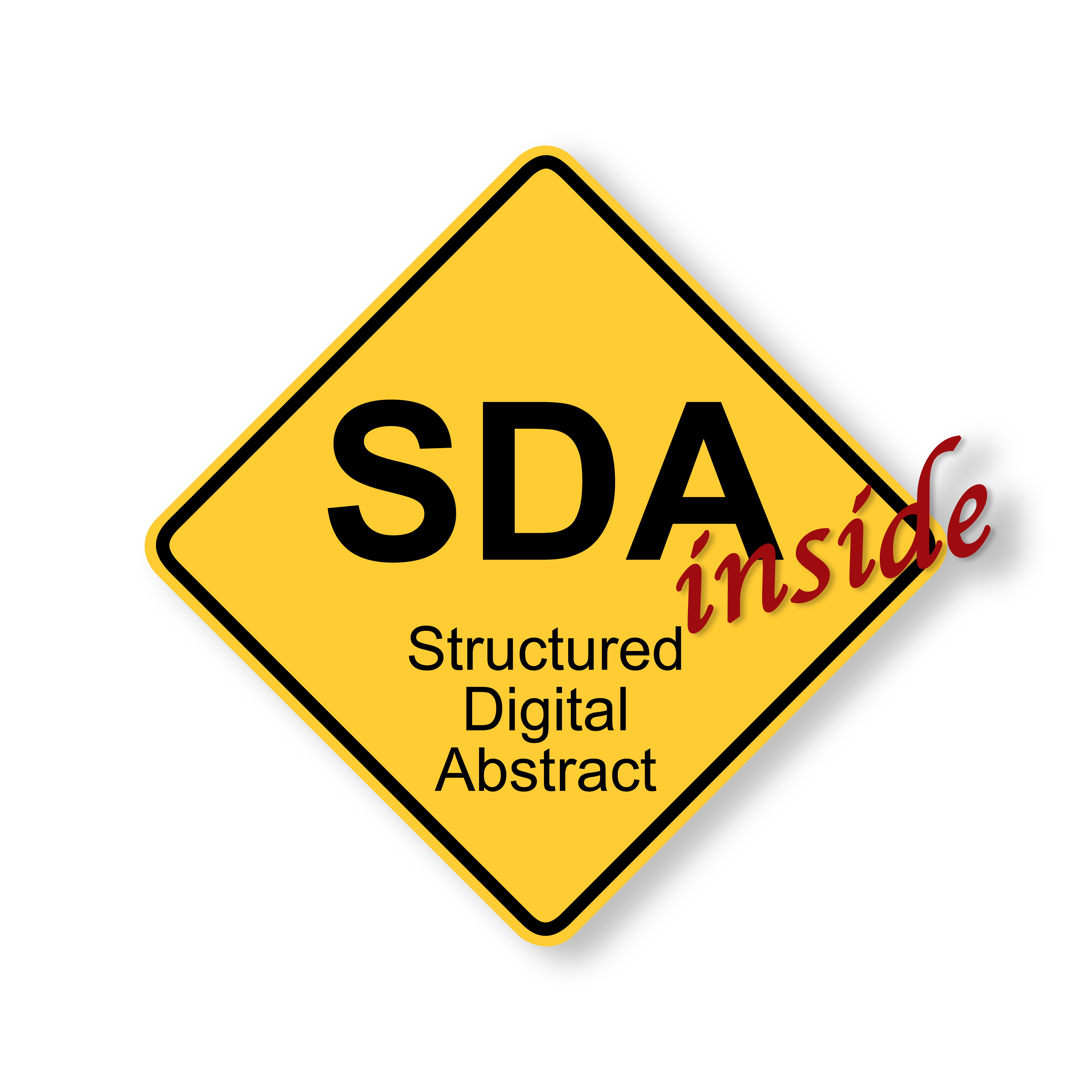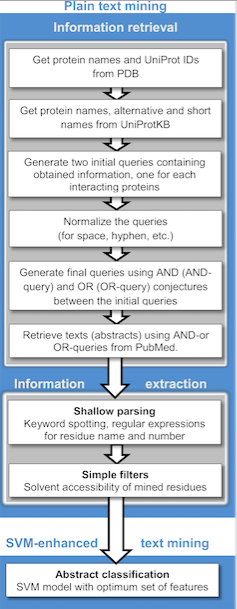|
Structured Digital Abstract
A Structured Digital Abstract (SDA) is a method of describing relationships between biological entities in a structured, but human-readable, format. It is added below the abstract of scientific articles published in FEBS Letters and FEBS Journal. Current SDAs describe protein-protein interactions. History Many scientific manuscripts describe relationships between entities such as genes and proteins. However, this information cannot be used efficiently because of the difficulties in retrieving it automatically from unstructured text.Finally: The digital, democratic age of scientific abstracts, Giulio Superti-Furga, Felix Wieland and Giovanni Cesareni, ''FEBS Lett'' (2009) 582, 1169 In a six-month pilot project that started in January 2008, FEBS Letters began publishing manuscripts with “structured digital abstracts” (SDAs). The SDAs were added to the end of abstracts in a structured, but human-readable, format and digitally linked to interaction databases. In the pilot projec ... [...More Info...] [...Related Items...] OR: [Wikipedia] [Google] [Baidu] |
FEBS Letters
''FEBS Letters'' is a not-for-profit peer-reviewed scientific journal published on behalf of the Federation of European Biochemical Societies (FEBS) by Wiley. It covers all aspects of molecular biosciences, including molecular biology and biochemistry. The aim of the journal is to publish primary research in the form of Research Articles, Research Letters, Communications and Hypotheses, as well as secondary research in the form of Review articles. The journal also publishes a News and Views column calle"The Scientists' Forum" The editorial office of ''FEBS Letters'' is based in Heidelberg, Germany. The journal income is reinvested in science. History The initial idea of ''FEBS Letters'' as a journal for rapid communication of short reports in biochemistry, biophysics and molecular biology was proposed by the Secretary General of FEBS, W.J. Whelan, at the 4th FEBS Meeting held in Oslo in 1967. After further discussions and preparations, the first issue of ''FEBS Letters'' appea ... [...More Info...] [...Related Items...] OR: [Wikipedia] [Google] [Baidu] |
FEBS Journal
''The FEBS Journal'' is a biweekly peer-reviewed scientific journal published by John Wiley & Sons on behalf of the Federation of European Biochemical Societies. It covers research on all aspects of biochemistry, molecular biology, cell biology, and the molecular bases of disease. The editor-in-chief is Seamus Martin (Trinity College Dublin), who took over from Richard Perham (University of Cambridge) in 2014. Content is available for free 1 year after publication, except review content, which is available immediately. The journal also publishes special and virtual issues focusing on a specific theme. Since 2021, the journal has given an annual award, "The FEBS Journal Richard Perham Prize", for an outstanding research paper published in the journal. The winners receive a €5,000 cash prize (to be divided equally between the first and last authors) and the senior author of the study is invited to give a talk at the FEBS Annual Congress. The journal also gives more frequent post ... [...More Info...] [...Related Items...] OR: [Wikipedia] [Google] [Baidu] |
Genes
In biology, the word gene (from , ; "... Wilhelm Johannsen coined the word gene to describe the Mendelian units of heredity..." meaning ''generation'' or ''birth'' or ''gender'') can have several different meanings. The Mendelian gene is a basic unit of heredity and the molecular gene is a sequence of nucleotides in DNA that is transcribed to produce a functional RNA. There are two types of molecular genes: protein-coding genes and noncoding genes. During gene expression, the DNA is first copied into RNA. The RNA can be directly functional or be the intermediate template for a protein that performs a function. The transmission of genes to an organism's offspring is the basis of the inheritance of phenotypic traits. These genes make up different DNA sequences called genotypes. Genotypes along with environmental and developmental factors determine what the phenotypes will be. Most biological traits are under the influence of polygenes (many different genes) as well as g ... [...More Info...] [...Related Items...] OR: [Wikipedia] [Google] [Baidu] |
Proteins
Proteins are large biomolecules and macromolecules that comprise one or more long chains of amino acid residues. Proteins perform a vast array of functions within organisms, including catalysing metabolic reactions, DNA replication, responding to stimuli, providing structure to cells and organisms, and transporting molecules from one location to another. Proteins differ from one another primarily in their sequence of amino acids, which is dictated by the nucleotide sequence of their genes, and which usually results in protein folding into a specific 3D structure that determines its activity. A linear chain of amino acid residues is called a polypeptide. A protein contains at least one long polypeptide. Short polypeptides, containing less than 20–30 residues, are rarely considered to be proteins and are commonly called peptides. The individual amino acid residues are bonded together by peptide bonds and adjacent amino acid residues. The sequence of amino acid residues in ... [...More Info...] [...Related Items...] OR: [Wikipedia] [Google] [Baidu] |
FEBS
The Federation of the European Biochemical Societies, frequently abbreviated FEBS, is an international scientific society promoting activities in biochemistry, molecular biology and related research areas in Europe and neighbouring regions. It was founded in 1964 and includes over 35,000 members across 39 Constituent Societies. Present activities FEBS activities include: publishing journals; providing grants for scientific meetings such as an annual Congress, Young Scientists’ Forum and FEBS Advanced Courses; offering travel awards to early-stage scientists to participate in these events; offering research Fellowships for pre- and post-doctoral bioscientists; promoting molecular life science education; encouraging integration of scientists working in economically disadvantaged countries of the FEBS area; and awarding prizes and medals for research excellence. FEBS collaborates with related scientific societies such as its Constituent Societies, the International Union of Biochemi ... [...More Info...] [...Related Items...] OR: [Wikipedia] [Google] [Baidu] |
BioCreative
BioCreAtIvE (A critical assessment of text mining methods in molecular biology) consists in a community-wide effort for evaluating information extraction and text mining developments in the biological domain. It was preceded by the Knowledge Discovery and Data Mining (KDD) Challenge Cup for detection of gene mentions. Community Challenges First edition (2004-2005) Three main tasks were posed at the first BioCreAtIvE challenge: the entity extraction task, the gene name normalization task, and the functional annotation of gene products task. The data sets produced by this contest serve as a Gold Standard training and test set to evaluate and train Bio-NER tools and annotation extraction tools. Second edition (2006-2007) The second BioCreAtIvE challenge (2006-2007) had also 3 tasks: detection of gene mentions, extraction of unique idenfiers for genes and extraction information related to physical protein-protein interactions. It counted with participation of 44 teams from 13 c ... [...More Info...] [...Related Items...] OR: [Wikipedia] [Google] [Baidu] |
Text Mining
Text mining, also referred to as ''text data mining'', similar to text analytics, is the process of deriving high-quality information from text. It involves "the discovery by computer of new, previously unknown information, by automatically extracting information from different written resources." Written resources may include websites, books, emails, reviews, and articles. High-quality information is typically obtained by devising patterns and trends by means such as statistical pattern learning. According to Hotho et al. (2005) we can distinguish between three different perspectives of text mining: information extraction, data mining, and a KDD (Knowledge Discovery in Databases) process. Text mining usually involves the process of structuring the input text (usually parsing, along with the addition of some derived linguistic features and the removal of others, and subsequent insertion into a database), deriving patterns within the structured data, and finally evaluation and int ... [...More Info...] [...Related Items...] OR: [Wikipedia] [Google] [Baidu] |
Protein
Proteins are large biomolecules and macromolecules that comprise one or more long chains of amino acid residues. Proteins perform a vast array of functions within organisms, including catalysing metabolic reactions, DNA replication, responding to stimuli, providing structure to cells and organisms, and transporting molecules from one location to another. Proteins differ from one another primarily in their sequence of amino acids, which is dictated by the nucleotide sequence of their genes, and which usually results in protein folding into a specific 3D structure that determines its activity. A linear chain of amino acid residues is called a polypeptide. A protein contains at least one long polypeptide. Short polypeptides, containing less than 20–30 residues, are rarely considered to be proteins and are commonly called peptides. The individual amino acid residues are bonded together by peptide bonds and adjacent amino acid residues. The sequence of amino acid resid ... [...More Info...] [...Related Items...] OR: [Wikipedia] [Google] [Baidu] |
UniProtKB
UniProt is a freely accessible database of protein sequence and functional information, many entries being derived from genome sequencing projects. It contains a large amount of information about the biological function of proteins derived from the research literature. It is maintained by the UniProt consortium, which consists of several European bioinformatics organisations and a foundation from Washington, DC, United States. The UniProt consortium The UniProt consortium comprises the European Bioinformatics Institute (EBI), the Swiss Institute of Bioinformatics (SIB), and the Protein Information Resource (PIR). EBI, located at the Wellcome Trust Genome Campus in Hinxton, UK, hosts a large resource of bioinformatics databases and services. SIB, located in Geneva, Switzerland, maintains the ExPASy (Expert Protein Analysis System) servers that are a central resource for proteomics tools and databases. PIR, hosted by the National Biomedical Research Foundation (NBRF) at the Georg ... [...More Info...] [...Related Items...] OR: [Wikipedia] [Google] [Baidu] |




